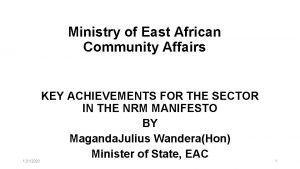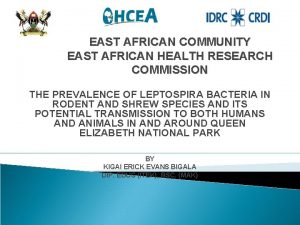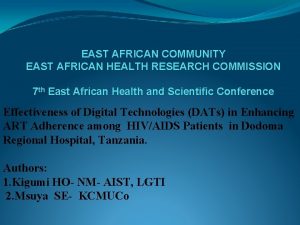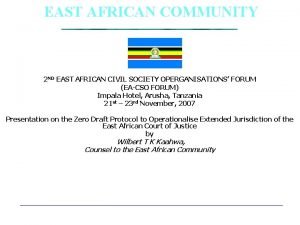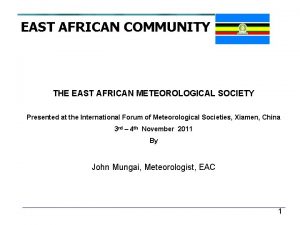EAST AFRICAN COMMUNITY EAST AFRICAN HEALTH RESEARCH COMMISSION














- Slides: 14

EAST AFRICAN COMMUNITY EAST AFRICAN HEALTH RESEARCH COMMISSION 7 th East African Health and Scientific Conference Effectiveness of Digital Technologies (DATs) in Enhancing ART Adherence among HIV/AIDS Patients in Dodoma Regional Hospital, Tanzania. Authors: 1. Kigumi HO- NM- AIST, LGTI 2. Msuya SE- KCMUCo

Introduction q Poor Adherence of ART treatment is Public health problem among the PLHIV q The problem results to diseases relapsing and drug resistant even the death q Digital adherence technologies (DATs)is the new approach which include computer application and phone based to facilitate ARV adherence and CTC clinic attendance q DATs approach reminded PLHIV on time for taking their medications and date for CTC attendance q Also DATs facilitate digital observation, compile patient histories and triage patients based on their level of adherence.

Component of DATs q Computer Data Base Ø Compiling the information participants Ø Create link between the data base and patients mobile phone Ø Sent alert Message or voice note to patient q Mobile Phone Ø Give an alert to patient for medication time and Clinic date Ø Sending feedback at the database

How DATs Functions that DATs can play to reinforce patient medication adherence and facilitate monitoring and triage of patients by health systems. ‘Differentiated care’ refers to providing different intensities and types of care based on a patient’s lev. GOel of medication adherence as measured by the DAT.

Objective of the study q Broad Objective: Ø To determine the effectiveness of the DATs on enhancing ART adherence and lost to follow among the HIV patient q Specific Objectives Ø To strengthen the management of HIV treatment Ø To asses acceptability of DATs on HIV treatment management

Materials and Methods q Prospective cohort study was done between June 2017 to July 2018 q 800 patients randomly selected from medical record at CTC Ø 400 were the intervention group Ø 4000 were control group q Interventional participants were given the mobile connect to computer data base for medication time alert and Date for clinic q Both intervention and control were anonymously visited to their home to approval for ART use q Digital feedback from interventional group were automatically recorded and approved during the home visit

Data collection and Data analysis q Data from interventional group collected from the data base, interview during the home visit and CTC clinic date q. Data from Control group collected through interview during home visit and CTC clinic q All data entered in SPSS 23. 0 for cleaning and analysis Frequencies is used for categorical data and standard deviations for continuous variables. Chi square, Fisher’s exact tests, and t-tests were used to compare the frequencies for categorical variables and the means of continuous variables from two groups Logistic regression models were used to predict factors associated with LTF and ART intake

Table 1: Social Demographic Characteristic for participants receiving ART treatment at Dodoma Regional Referral Hospital Characteristics Comparison Group Intervention Group P-value N= 400 n(%) Mean, SD Male 192(48. 0) 116(29. 0) Female 208(52. 0) 284(71. 0) 0. 030² Mean age 37(9. 10) 46(9. 7) < 0. 0001 ² <30 130(32. 50) 128(32. 0) ≥ 30 270(67. 50) 272(68. 0) 202(50. 50) 205(51. 30) Married/cohabit 198(49. 50) 195(48. 70) Sex Age Group <0. 0001 Marital Status Single/divorced 0. 030²

Table 2: ART and LTFU Characteristic for participants receiving ART treatment at Dodoma Regional Referral Hospital Characteristics Comparison Group Intervention Group N= 400 n(%) Mean, SD P-value Adherence to ART medication and 112(28. 0) CTC attendance 288(67. 0) < 0. 0001 2 Lost To Follow Up 288(67. 0) 80 (20. 0) < 0. 0001 2 Transfers to another ART clinic 20(5. 0) 32(8. 0) < 0. 0001 2

Table 3: Univariate Comparison Group Covariate of Interest analysis of Univariate Intervention vs. P-value Effects Estimate Intervention VS Comparison Time for ART intake 0. 9 ( -6. 97 , 8. 71) 0. 8270 Intervention group 0. 14 (-0. 073, 0. 35) 0. 200 Comparison group 0. 15 (-0. 003, 0. 31) 0. 200 0. 9 (0. 51, 0. 76) <0. 0001 0. 92 (0. 91, 0, 93) <0. 0001 Lost To Follow Up Intervention VS Comparison LTFU change over time Intervention

Discussion of findings q The study examining DATs effectiveness on ART treatments and LTFU q The participants exposed to Intervention show significance improvements on ART treatment q DATs lower the rate of LTFU and participants were more likely remain on treatment q Age and gender reported to be associated with ART treatment and LTFU q The risks factors for were all independently significance associated to ART treatment and LTFU q The results for study is similar to what was observed in in Zimbabwe and Zambia where known as “mothers 2 mothers” (m 2 m) was found to improve retention and adherence to the Option B+ antiretroviral regimens among HIV infected women

Conclusion and Recommendation q The findings suggest that providing additional information on DATs application q More Research is needed to understand the acceptability DATs on ART management and LTFU for PLHIV q Needs for supports from implementers and policy makers should support formalize the Use of DATS on HIV treatments managements

References q Haberer JE, Musiimenta A, Atukunda EC, et al. Short message service (SMS) reminders and real-time adherence monitoring improve antiretroviral therapy adherence in rural Uganda. AIDS 2016; 30: 1295– 9. q Haberer JE, Musinguzi N, Tsai AC, et al. Real-time electronic adherence monitoring plus followup improves adherencecompared with standard electronic adherence monitoring. AIDS 2017; 31: 169– 71. q Liu X, Blaschke T, Thomas B, et al. Usability of a Medication Event Reminder Monitor System (MERM) by providers and patients to improve adherence in the management of tuberculosis. Int J Environ Res Public Health 2017; 14: 1115. q Karfakis EKa. J. Current practices to increase uptake, retention and adherence for option B+ in Malawi. Mothers to mothers Malawi 2014 (cited 2016 August 26). https: //www. m 2 m. org/wpcontent/uploads/2014/10/ m 2 m_Malawi-PMTCT-Report. pdf q Shroufi A, Mafara E, Saint-Sauveur JF, Taziwa F, Vinoles MC. Mother to mother (M 2 M) peer support for women in prevention of mother to child transmission (PMTCT) programmes: a qualitative study. Plo. S ONE. 2013; 8(6): e 64717

Acknowledgement 1. Nelson Mandela African Institutive Of Sciences and Technology(NM-AIST), Arusha 1. Local Government Training Institute (LGTI), Dodoma 1. Kilimanjaro Christian medical University College, (KCMUco) Moshi , Kilimanjaro. 1. Dodoma Regional Referral Hospital (DRRH), Dodoma 11/30/2020 1 14
 Ministry of east african community affairs uganda
Ministry of east african community affairs uganda Mchrc
Mchrc European commission community research
European commission community research Mudaliar commission is known as
Mudaliar commission is known as What is graduated commission
What is graduated commission Role of occupational health nurse
Role of occupational health nurse Conceptual skills examples
Conceptual skills examples Religion in east africa
Religion in east africa Types of tectonic plates
Types of tectonic plates East african lion
East african lion East african rift
East african rift African tea uganda
African tea uganda Crpc baton rouge
Crpc baton rouge West african community council kent
West african community council kent Person and community in african thought
Person and community in african thought
